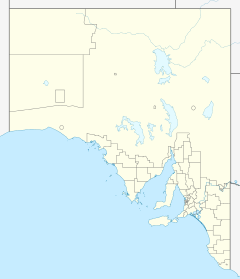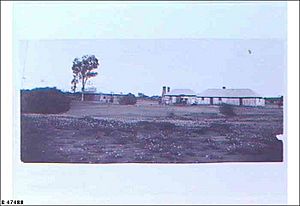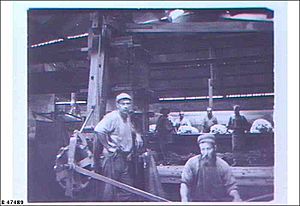Nilpena facts for kids
Nilpena Station is a large property in the northern Flinders Ranges of South Australia. It's a type of farm called a cattle station, where cows are raised. Before that, it was a sheep station, raising sheep.
In 1985, incredible Ediacaran fossils were found on the station. These fossils are from some of the earliest complex life on Earth! Because of how important these fossils are, about two-thirds of the property was sold to the Government of South Australia in 2016. This land became part of the Nilpena Ediacara National Park, which officially opened in 2021. As of May 2023, the Fargher family still owns the remaining part of Nilpena Station.
Contents
History of Nilpena Station
Nilpena Station has a long and interesting history. In 1859, two important people named Thomas Elder and Robert Barr Smith bought the property.
Early Droving Feats
In 1879, William James Browne owned Nilpena. He sent a drover named Giles on an amazing journey. Giles took 12,000 sheep from Nilpena and moved them a very long distance, all the way to Browne's new properties called Newcastle Waters and Delamere Station. Even though only 8,000 sheep made it, this trip was considered one of the most incredible droving achievements in Australian history! Browne then put Roderick John Matheson in charge of Nilpena, as well as another property called Arkaba Station.
Later, Matheson and John Lewis bought Nilpena together. Eventually, Matheson bought out Lewis and became the sole owner.
Changes and Challenges
In 1925, the older part of Nilpena Station was put up for sale. At that time, it was about 31,404 acres (127 square kilometers) and had over 3,000 merino sheep. However, it didn't sell for the price the owners wanted.
Matheson still owned the property in 1926, along with a nearby station called Warrioota. Together, these properties covered about 350 square miles (906 square kilometers). He was raising around 15,000 sheep across both. By 1931, Colin Matheson and his wife had taken over running the station.
For some years between the 1930s and early 1950s, both sheep and cattle were raised on Nilpena. In 1944, the property had about 7,000 sheep.
In 1950, Nilpena Station, run by the Nilpena Pastoral Company, experienced a huge amount of rain. It received 11.6 inches (295 millimeters) of rain in just three days, which was like 18 months' worth! Over 10,000 acres (40 square kilometers) of the 216,000-acre (874 square kilometers) property were completely underwater. The manager at the time believed this rain would provide enough food for the animals for the next two years.
Nilpena Station was described in 1950 as being about 44 kilometers (27 miles) west of Blinman and 99 kilometers (62 miles) north of Hawker, in the Flinders Ranges, and bordered by Lake Torrens.
Discovery of Ancient Life
Before the 1980s, Nilpena changed completely to a cattle station. The Fargher family bought the property. In 1985, Ross Fargher made an amazing discovery: a perfectly preserved site with Ediacaran fossils! This discovery led to important scientific research. There's even an application to make it a World Heritage Site to help protect these ancient treasures.
In 2009, the station covered an area of about 800 square kilometers (309 square miles). In 2016, the Government of South Australia bought two-thirds of Nilpena Station from the Fargher family. This was done to make the Ediacara Conservation Park bigger and to protect the land where these valuable fossils were found.
Nilpena Ediacara National Park
In 2021, a large part of the land was officially named Nilpena Ediacara National Park. This park opened to visitors in April 2023. Ross and Jane Fargher, who have worked for many years with the national parks program, are currently looking after the fossil beds until a park ranger is appointed.
Nilpena in the Media
In 2009, the amazing fossils and the Nilpena property were shown on the David Attenborough TV series First Life.




